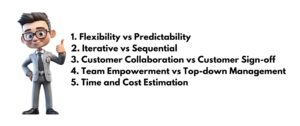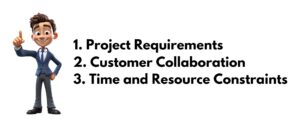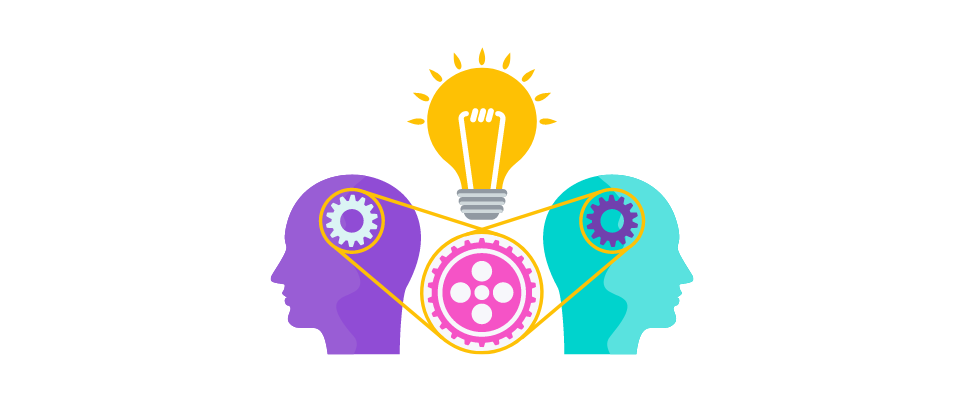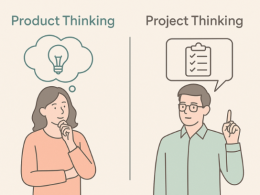Are you a Product Manager looking to navigate the maze of project management methodologies? Curious about the differences between Agile and Waterfall?
Look no further!
In this blog post, we will guide you through the distinctions between Agile and Waterfall methods in a conversational and easy-to-understand manner.
By the end, you’ll have a solid grasp of the differences and be equipped to make informed decisions for your projects.
Let’s dive in!
Agile vs Waterfall Methods: A Product Manager’s Guide to the Differences
What is Agile?
Imagine you’re embarking on a project where requirements might change, and flexibility is key. Agile, a highly iterative and collaborative approach, embraces change and promotes adaptive planning. It breaks the project into smaller increments called sprints, allowing for frequent feedback, continuous improvement, and faster delivery.
Agile enables teams to respond to customer needs and market dynamics swiftly, enhancing product quality and customer satisfaction.
On the other hand, Waterfall…
Now, let’s dive into Waterfall, a traditional and sequential methodology.
Picture a scenario where the project scope, requirements, and timeline are well-defined from the beginning. Waterfall follows a linear flow, progressing through distinct phases such as requirements gathering, design, development, testing, and deployment.
Each phase must be completed before moving to the next, making Waterfall suitable for projects with stable and predictable requirements.
The Key Differences
Agile and Waterfall have fundamental differences in their approach to project management.

Here are some key distinctions that Product Managers should be aware of:
1. Flexibility vs Predictability
Agile embraces change and welcomes evolving requirements throughout the project, while Waterfall emphasizes upfront planning and relies on fixed requirements.
2. Iterative vs Sequential
Agile follows an iterative approach with shorter development cycles, allowing for continuous feedback and adaptation. Waterfall, on the other hand, progresses linearly through distinct phases, making it less flexible to change.
3. Customer Collaboration vs Customer Sign-off
Agile encourages frequent customer collaboration and feedback, ensuring the product aligns with their evolving needs. In Waterfall, customer involvement is typically limited to the early stages, with final sign-off occurring towards the end of the project.
4. Team Empowerment vs Top-down Management
Agile empowers cross-functional teams, promoting self-organization and autonomy. Waterfall relies on hierarchical management structures, with tasks assigned from the top down.
5. Time and Cost Estimation
Agile focuses on relative estimation, using techniques like story points to gauge effort. Waterfall emphasizes detailed upfront planning and estimation based on a defined scope.
Choosing the Right Method
As a Product Manager, selecting the appropriate method for your project is crucial.

Consider the following factors when making your decision:
1. Project Requirements
Assess the stability and predictability of requirements. Agile is better suited for dynamic and evolving projects, while Waterfall is ideal for stable and well-defined projects.
2. Customer Collaboration
Evaluate the level of customer involvement and feedback required. Agile allows for frequent collaboration, while Waterfall relies on upfront customer input.
3. Time and Resource Constraints
Consider project timelines and resource availability. Agile’s iterative nature can allow for faster delivery, while Waterfall’s linear approach may be more suitable for strict deadlines.
As a Product Manager, understanding the differences between Agile and Waterfall methods is essential for successful project management. Agile provides flexibility, adaptability, and customer collaboration, while Waterfall offers predictability and structured planning.
By considering project requirements, customer involvement, and resource constraints, Product Managers can make informed decisions to choose the most suitable approach. Remember, it’s not about which method is superior, but rather which method aligns best with the specific needs of your project.
So, whether you’re embarking on a dynamic and evolving project or working on a stable and well-defined endeavor, being aware of the differences between Agile and Waterfall methods will empower you to navigate the project management maze with confidence.
In the world of Agile, embracing change is a key principle. By breaking the project into smaller sprints, teams can deliver incremental value and gather feedback along the way. This iterative approach allows for quick adaptations, ensuring that the final product meets customer expectations effectively. Agile empowers teams to collaborate closely with customers, fostering a shared understanding and driving customer satisfaction.
On the other hand, Waterfall takes a more structured and sequential approach. With well-defined requirements upfront, teams follow a linear progression from one phase to another. This method is beneficial when the project requirements are stable and predictable, allowing for meticulous planning and a clear timeline. However, it can be less adaptable to changes that may arise during the project.
As a Product Manager, your role is to evaluate these factors and make informed decisions. Remember that Agile and Waterfall are not mutually exclusive, and hybrid approaches can be adopted to leverage the strengths of both methods.
In conclusion, understanding the differences between Agile and Waterfall methodologies is vital for Product Managers. By being aware of their distinct characteristics, you can choose the most suitable approach for your projects, leading to successful outcomes and satisfied stakeholders. So, embrace the versatility of Agile or the structure of Waterfall, and steer your projects towards success in the ever-evolving world of product management.
Start your journey today by exploring our insightful blog page and unleash your potential in this dynamic field. Don’t miss this chance to excel in product management with Accredian!






